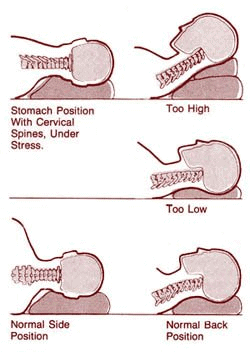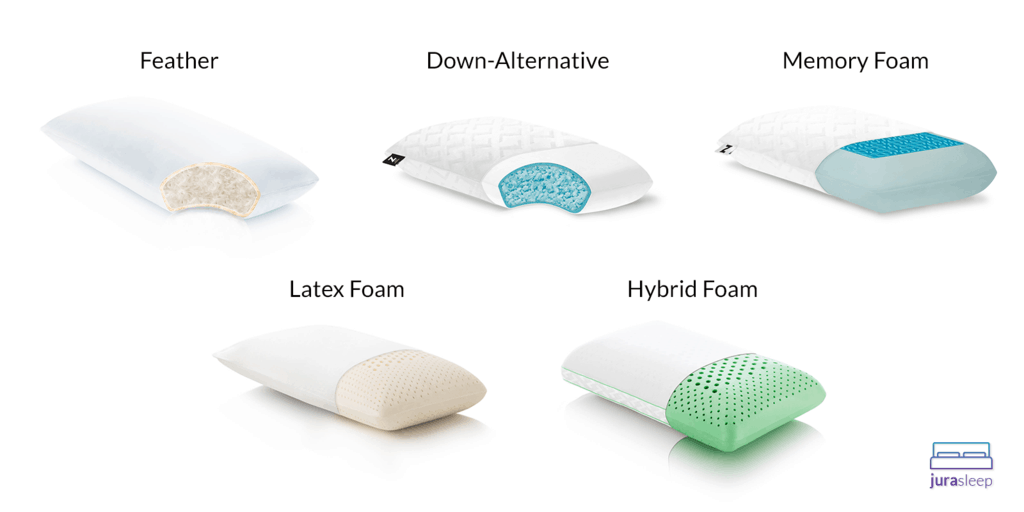Choosing the perfect pillow can be tough. When I go pillow shopping it takes me a few stores and a few hours to find the perfect pillow. To make sure I love it, sometimes I even lay on the floor with the pillow. Weird, I know.
Choosing a pillow is just as important as choosing the right mattress. Sleeping with a worn out pillow can cause problems down the road for your body. Depending on how you sleep, more than one pillow might be necessary in keeping your spine aligned. The pillow for your neck/head should support the natural curve your neck has and be comfortable. Too high of a pillow may put your neck in a position that strains muscles in your back, neck, and shoulders.
Why Does My Pillow Matter
People love the term “I slept like a baby”. Well, to sleep like a baby you must have good sleeping posture. This starts with a perfect pillow. If your neck and shoulders are not getting sufficient support, this can put the spine and body out of alignment. In return this leads to strains and discomfort in the neck, shoulders, and back, along with sleeplessness. Though support is the most important in selecting your pillow, you also want one that is comfortable.
When to Replace Your Pillow
While memory foams pillows can last up to three years, regular bed pillows last anywhere between 12-18 months. Pillows older than 12-18 months do not provide the proper support and are probably the reason you are not sleeping comfortably.
Simple tests can help see if your pillow needs to be replaced.
Sight and Smell Test
Take your pillow case off and examine the pillow. Are there stains on the pillow? How about tears? Does your pillow have a weird smell? If any of these answers are yes, your pillow needs to be replaced. Pillows collect dead skin cells, mildew, mold, fungus, and dust mites. As your pillow ages, over half of its weight can be attributed to these organisms.
The Fold Test
This test is very simple, just fold your pillow in half. If it lies there instead of springing back to its shape, it is a “dead pillow” and should be replaced. Pillows with natural fill can be tested over the arm. If the pillow drapes and hangs down, then it needs to be replaced. Synthetic pillows can be folded in half and have weight added to them, a shoe works. Pick the shoe up and see if the pillow springs back up to its original shape. If it doesn’t, then the pillow needs to be replaced. King-sized pillows can be done too, but folded into thirds instead of in half.
Picking a Pillow
Choosing a pillow is based on an individual preference. Determining what you find the most comfortable and appropriate for you is the best way to choose your perfect pillow. However, the six elements below can be used as a guide to help you.
The Pillows Fiber
Down pillows are described as light and soft. They are usually made from duck or goose fibers. Down pillows are made from an array of combinations. Some pillows such as “pure down” and “all down” may contain feathers or other fillers that they typically don’t. Synthetic down and polyester fill pillows tend to be less expensive than natural down pillows. However, they need to be replaced more often. These pillows tend to be medium to soft and more soft then compared to a down pillow.
The Pillows Filling
The higher the fill power number, the better the pillows quality. But just because it has a 600 fill power or 800 fill power doesn’t mean the pillow itself will last for 18months or longer.
Wool filled pillows are naturally hypo-allergenic and are resistant to mold and dust mites. Pillows filled with wool also wick away moisture from your head and neck and are effective at regulating your temperature when sleeping. Cotton pillows are very similar to wool in the ways of being hypo-allergenic and resistant to mold and dust mites. While cotton pillows are a smart choice for people with allergies and chemical sensitivities they can be flat and firm.
Latex pillows are more firm than down but are still found to be very comfortable. However, if you like to squish your pillow into the position of your choice, then latex pillows are not for you as they hold their shape. Latex pillows are resistant to mold and dust mites and they contour to the head and neck to help restrict movement during sleep. Lastly, memory foam pillows which conform to your individual shape. Memory foam pillows respond to a persons weight and body heat which then softens the memory foam contouring to the lines of the head, neck, and shoulders. Weight is also distributed evenly across the pillows surface.
The Fill Weight
The weight of your pillow comes as a personal preference. I sleep with a heavier pillow and it’s very comfortable to me while someone I know sleeps with a very light pillow and that’s comfiest to them. Memory foam and latex pillows tend to be the heavier pillow choices. Down and synthetic pillows are the lightweight choices. People who tend to reshape their pillow and move their pillow with them while sleeping typically prefer a lighter weight pillow.
The Fills Quality
The average person sleeps for 7-8 hours a night. That’s over 2,500 hours a year so you’re going to want a pillow that has the highest quality of fill your budget allows. Price reflects the comfort, support, and longevity so choose what works for you but one that also has a great fill quality.
Pillow Size
I prefer bigger pillows but most people are fine with the standard pillow size. The pillows thickness or thinness should allow you to sleep with your head, neck, and shoulders in alignment with the spine and provide you comfort. Your pillow case and pillow cover should also fit properly.
Pillows Fabric
Natural and breathable fabrics should be used to cover the pillow. Using covers under the pillowcase also help extend the life of the pillow because it helps protect from stains and sweat.
The Chemistry
Pillows made with synthetic materials such as memory foam and polyester go through chemical processes with many pillows being put through antimicrobial treatments. Know how your pillow is made and be willing to spend the money for a great investment. Also, consider your personal allergies and chemical sensitivities when selecting your pillow.
Body Alignment
Regardless of how you sleep though, you should try and keep the ears, shoulders, and hips aligned.
If you sleep on your back, putting a small pillow under the back of your knees can help reduce stress on the spine while supporting the natural curve of the lower back. As stated above, the pillow for your head should support the head, natural curve of the neck, and shoulders.
Sleeping on your stomach may create stress on your back. This happens because the spine may be put out of alignment. Putting a flat pillow underneath the stomach and pelvis can help keep the spine in better alignment.
Side sleepers should put a firm pillow between their knees. This helps prevent the upper leg from pulling the spine out of alignment while reducing stress on the hips and lower back. Also, pulling your knees up towards your chest slightly helps too.
Picking the perfect pillow can feel overwhelming but it aides in a better nights sleep and your body health. Next time you decide to buy a new pillow think about investing in a good one instead of a $5 one from the local store.



